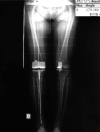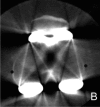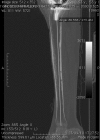Computer assisted total knee arthroplasty: a real navigation to better results?
- PMID: 28657564
- PMCID: PMC6179005
- DOI: 10.23750/abm.v88i2-S.6513
Computer assisted total knee arthroplasty: a real navigation to better results?
Abstract
Background and aim of the work: Computer assisted surgery in knee replacement is still in discussion, but majority of papers affirm an increase of the accuracy in alignment. Aim of our study is to evaluate the accuracy of mechanical axis, the posterior tibial slope and the femoral component rotation with navigation, x-ray and CT data.
Methods: We have analysed 145 patients who underwent total knee arthroplasty between January 2012 and December 2014. We have checked each patient at 6, 12 and 24 months of follow-up. During each visit, we did a clinical evaluation checking the ROM and a clinical score (KOOS). At 2 years, we did a CT evaluation and a plain x-ray evaluation.
Results: 125 patients have completed the follow-up. Mean follow-up time was 2,6 years. Both ROM and KOOS values increased during follow-up. About the mechanical axis, both x-ray and CT data showed a mean deviation <2° from the target. About posterior tibial slope and femoral component rotation, CT data showed a mean deviation of <3° from the target. Mean difference between navigation and CT data was <1°.
Conclusions: According to literature data, our data confirm that computer assisted surgery in knee replacement have a good accuracy of coronal alignment, rotational alignment and posterior tibial slope.
Keywords: otal knee arthroplasty, knee surgery, computer-assisted surgery, knee prosthesis, computer navigation, mechanical axis, posterior tibial slope, femoral component rotation.
Figures





Similar articles
-
Comparison of robot-assisted and conventional total knee arthroplasty: a controlled cadaver study using multiparameter quantitative three-dimensional CT assessment of alignment.Comput Aided Surg. 2012;17(2):86-95. doi: 10.3109/10929088.2012.654408. Comput Aided Surg. 2012. PMID: 22348661
-
Component position alignment with patient-specific jigs in total knee arthroplasty.ANZ J Surg. 2014 Sep;84(9):628-32. doi: 10.1111/ans.12674. Epub 2014 Jun 19. ANZ J Surg. 2014. PMID: 24946273 Clinical Trial.
-
[Rotational alignment of femoral component with computed-assisted surgery (CAS) during total knee arthroplasty].Rev Chir Orthop Reparatrice Appar Mot. 2008 Oct;94(6):580-4. doi: 10.1016/j.rco.2008.03.038. Epub 2008 May 27. Rev Chir Orthop Reparatrice Appar Mot. 2008. PMID: 18929753 French.
-
Imageless navigation system does not improve component rotational alignment in total knee arthroplasty.J Surg Res. 2011 Dec;171(2):590-600. doi: 10.1016/j.jss.2010.05.006. Epub 2010 Oct 31. J Surg Res. 2011. PMID: 21176919 Review.
-
Computer Navigation-Assisted Knee Replacement Demonstrates Improved Outcome Compared with Conventional Knee Replacement at Mid-Term Follow-up: A Systematic Review and Meta-analysis.Indian J Orthop. 2020 Jun 13;54(6):757-766. doi: 10.1007/s43465-020-00161-z. eCollection 2020 Nov. Indian J Orthop. 2020. PMID: 33133398 Free PMC article. Review.
References
-
- Haaker R. Evolution of total knee arthroplasty. From robotics and navigation to patient-specific instruments. Orthopade. 2016;45(4):280–5. - PubMed
-
- Sardana V, Burzynski JM, Khan M, Stone N, Weening BS, Zalzal PK. Long-term functional outcomes and knee alignment of computer-assisted navigated total knee arthroplasty. Musculoskelet Surg. 2017;101(1):37–43. - PubMed
-
- Han SB, Kim HJ, Kim TK, In Y, Oh KJ, Koh IJ, et al. Computer navigation is effective in reducing blood loss but has no effect on transfusion requirement following primary total knee arthroplasty: a meta-analysis. Knee Surg Sports Traumatol Arthrosc. 2016;24(11):3474–81. - PubMed
-
- Steiger RN, Liu YL, Graves SE. Computer navigation for total knee arthroplasty reduces revision rate for patients less than sixty-five years of age. J Bone Joint Surg Am. 2015;97(8):635–42. - PubMed
-
- Delp SL, Stulberg SD, Davies B, Picard F, Leitner F. Computer assisted knee replacement. Clin Orthop Relat Res. 1998;354:49–56. - PubMed
MeSH terms
LinkOut - more resources
Full Text Sources
Medical
Research Materials
